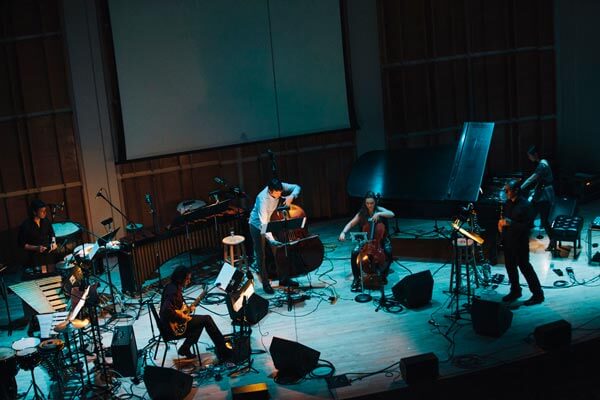Bang on a Can All-Stars – Photo by David Andrako
The Bang on a Can All-Stars ensemble for the evening was an eclectic mix of instruments – electric guitar, percussion, piano, keyboards, cello, and bass – and a wide variety of expert musicians.The concert was broadcast live and hosted by WNYC’s John Schaefer, who provided the audience with a brief, intimate interview with each of the composers before their works were performed. This set the mood for the audience, which appeared to be much more laid back in comparison to many New York concert events.
Multimedia was a key component of the concert, with every composer utilizing some sort of electronic element in their works. The initial piece on the program, from Icelandic-born composer Jóhann Jóhannsson, was named, Hz, the basic measure of both electricity and musical frequencies. The performance of Hz not only included prepared field recordings but video as well. Projected behind the ensemble was a short film which included images of gears and machinery, in operation at a hydroelectric power station built in the 1920’s near Reykjavik. The images were recorded by Jóhannsson himself on a Super 8 camera, and included sounds from the machinery at the power station that he processed, manipulated, and synced to the score. Washed out images of the machinery in movement made it easy to get lost and forget the ensemble was playing underneath, making the whole experience feel like an interactive film score.
Composer Anna Clyne (photo credit: © Chicago Tribune)
Works by English-born composer Anna Clyne and New York-based Paula Matthusen went with different approaches: they incorporated the unique sounds of their own surroundings. Clyne’s work, A Wonderful Day, incorporated the sound of a man, Woody Barbee, singing as she recorded him (with permission) on her iPhone, walking by on Chicago’s Magnificent Mile. The voice of Barbee – played as a chopped prepared tape – was raw yet joyful, and Clyne’s use of the ensemble to accompany it was seemingly simple. The structure was well crafted and she incorporated a vast spectrum of texture well suited to the ensemble’s unique cast of instrumentation.
Matthusen’s contribution, ontology of an echo, was the result of her “longstanding fascination with the subterranean” in New York and it’s “immense and labyrinthine infrastructure” spanning a vast centuries-old underground architecture. For her field recording she went to the Old Croton Aqueduct and experimented with various locations to capture the echoing sounds of “drips and cool air.” The piece began with a simple exercise: shifting back and forth between the taped, rhythmic fragments of sound and the ensemble’s precise, almost pizzicato, articulations. These eventually morphed into long melodic lines, expanding the harmony as Matthusen mapped a lost sense of space and time, temporarily changing the entire acoustic of the concert hall.
Composer Dan Deacon (photo credit: Dan Deacon)
When Dan Deacon arrived to the stage to be interviewed, his disposition was a lot more humble and excited than his counterparts. “If this doesn’t work just turn off your phones and pretend this didn’t happen,” he exclaimed while making his way towards the back of the stage to enable the smartphone app that would interact with his composition. Deacon’s Sago An Ya Rev is characterized in the program notes as a “slow morphing transcription” of the NASA Voyager lift-off. The piece is a prolonged crescendo and decrescendo transforming the concert hall into an acoustic cockpit. A corporate drone from the ensemble served as the foundation, as the crowd’s smartphones functioned as a “spacial light and sound source.” Deacon’s app took control of their phones to produce sounds, flashes, and a colorful screen display.
Changing the tone of the concert was Fay Keeun Wang‘s Weltinseln, a Kant term in German which means “Island Universe.” Wang explained that she wrote this piece while moving between apartments or, in her view, “different universes.” The score was broken into many parts and included a variety of musical and stylistic nods to Björk. Wang, working with the ensemble, used many extended techniques, including with her voice, as she made herself the front-and-center attraction of the piece.
Composer Tyondai Braxton (photo credit: Nomo Michael Hoefner)
Tyondai Braxton has a long resume in experimental music and his projects have been receiving a lot of attention lately: from reworking Philip Glass to sound installations at the Guggenheim. Braxton’s TREMS is a piece in two parts which utilizes rhythmic pulses from his field recordings. The first part, Casino Trem, makes playful use of the rhythms of slot machines (capturing them was a risky venture, considering he was asked to leave the casino). The second part was the Organ Trem made from a simple “software organ.” TREMS contrasted with many of the other works on the program in that, instead of layering the recordings on top of the ensemble, he cut the material rhythmically to “occupy the same universe as the Bang on a Can All-Stars.”
This Bang on a Can All-Stars program offered something for everyone. Although the concert was filled with new music, there were no riots and, in fact, there appeared to be many satisfied faces. Most importantly, it was encouraging to see that new music has a healthy and vibrant future. Projects like the Bang on a Can People’s Commissioning Fund and the Ecstatic Music Festival will continue to build audiences who are anxious to find new sounds and experiences.

All photos © David Andrako
–
Daniel Garrick is an emerging composer, active performer, writer, and creative thinker residing in Jersey City. Follow him on Twitter: @realfaustus.
